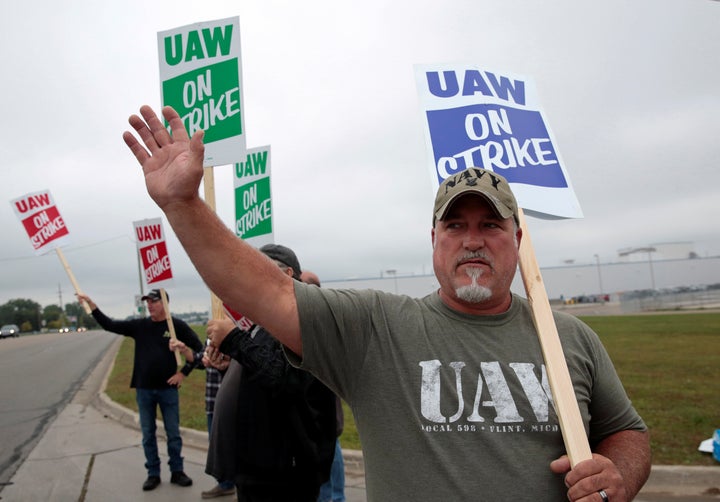General Motors workers across the country walked out of plants at midnight Monday as the largest U.S. auto strike in more than a decade got underway.
The United Auto Workers called for the work stoppage after the union failed to reach a new collective bargaining agreement covering some 46,000 workers at dozens of facilities. GM and the union remained far apart in negotiations on Sunday, when UAW leaders converged on Detroit and decided overwhelmingly to strike after their contract expired over the weekend.
There’s no telling how long the impasse could last. Shutting down plants is extremely costly for GM and within weeks could lead to slimming choices for buyers on dealer lots. But workers could start to feel pain, too, as they try to eke by on union strike pay of just $250 per week, a fraction of what the typical employee earns.
The massive strike wasn’t hard to see coming. As HuffPost reported in July, GM has been enormously profitable ― though profits have recently been falling ― and workers who sacrificed during the auto industry’s crisis in 2007 are expecting a bigger share of the gains.
At the same time, GM is intent on keeping its labor costs down as the company braces for a sales slowdown and pumps money into electric and autonomous vehicles.

Meanwhile, the company’s announcement last year that it would idle five plants in the U.S. and Canada has left many workers bitter. Those affected have either lost their jobs or had to pick up and move their families in order to maintain GM work at another facility. The union has made a top priority of securing new production at some of the idled plants through the contract talks.
Negotiators in the quadrennial contract talks are typically tight-lipped, but GM took the rare step on Sunday of publicly releasing the outlines of its offer to the union that was rejected. It included $7 billion in investments and “solutions for unallocated assembly plants in Michigan and Ohio” ― that is, some form of work going to two plants scheduled for idling. GM said it had plans for a production line for electric trucks and a site for battery manufacturing.
The company did not specify the wages or health care coverage offered, except to say it put raises on the table and promised to “retain nationally-leading health care benefits,” a formulation that could easily mean higher out-of-pocket expenses for workers. GM workers generally have very good health coverage ― a necessity, they maintain, for the taxing work ― and the company has been eager to pare costs.
Scenes from Michigan, Kentucky and elsewhere showed workers hitting the picket lines right at midnight. Workers assigned to the morning shifts showed up to picket instead of reporting for work.
The broad brushes of GM’s deal didn’t address two obvious sticking points in the talks: the time it takes workers to earn top pay, and the company’s use of temporary workers. In 2007, the union agreed to a two-tiered wage system that put newer hires on a lower pay scale than more senior workers. While their 2015 agreement created a pathway for those workers to earn the top rate of around $30 per hour, it now takes eight years for them to get there ― a system known as “in-progression.”
Many workers demand that runway be shortened. They also want to see GM using fewer temps ― the company says around 7% of its production workforce is temporary ― and converting them to traditional positions.
Sean Crawford, a materials handler at GM’s Flint, Michigan, truck assembly plant, epitomizes many of the thorny issues at the bargaining table. As a post-2007 hire, he needed to work eight years before topping out. And, as someone who was working at the Detroit-Hamtramck plant slated to be idled, he had to move back to Flint in order to keep his job.
Crawford told HuffPost ahead of the strike that he was more than willing to walk out, if that’s what it took.
“It’s one of those built-in, divide-and-conquer strategies that benefits the company,” Crawford said of temps and the in-progression system. “It’s a very real division and it needs to be addressed.”
This year the UAW is negotiating new contracts with all of the Big Three automakers ― GM, Ford and Fiat Chrysler. It chose to talk with GM first, and the contract it ultimately reaches with the company generally sets the framework for talks with the other two companies to follow, a system known as “pattern bargaining.” The union extended its earlier agreements with Ford and Fiat Chrysler as it bargained with GM, meaning there is no immediate likelihood of a strike at those companies.
At the same time it is trying to reach crucial new contracts, the UAW is facing a widening corruption probe in Detroit ― a dynamic that puts even more pressure on union leadership to score wins at the bargaining table. Last week a high-ranking union official was charged with embezzlement and money laundering. The indictment included embarrassing details that play into stereotypes of union corruption, like $60,000 spent on cigars.
The Detroit News reported that UAW President Gary Jones is directly implicated in the probe, as an unnamed union official in court papers. Jones’ house was searched in August.
The potential misuse of member dues has made plenty of UAW members pessimistic about leadership. As Crawford told HuffPost, winning a good contract is “probably the only thing” that could restore confidence for many members.
The union and GM were expected to resume talks on Monday.

